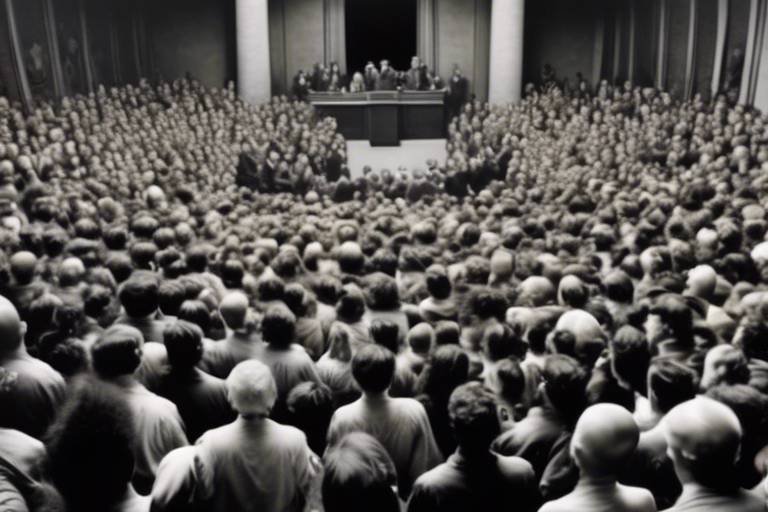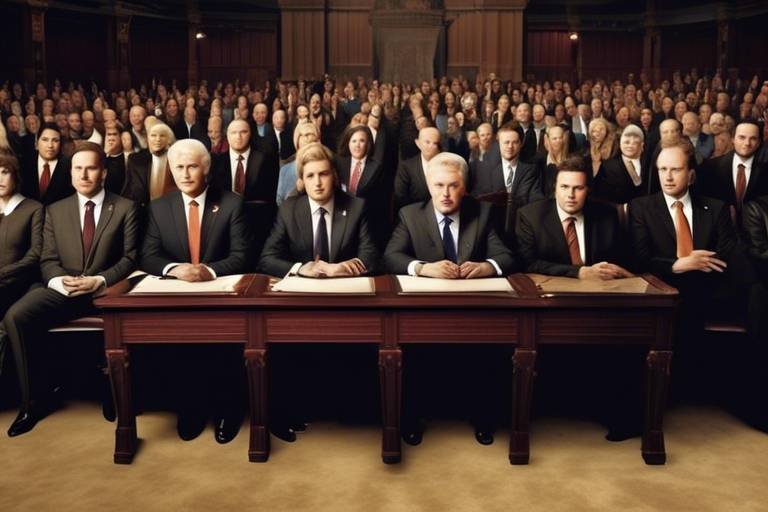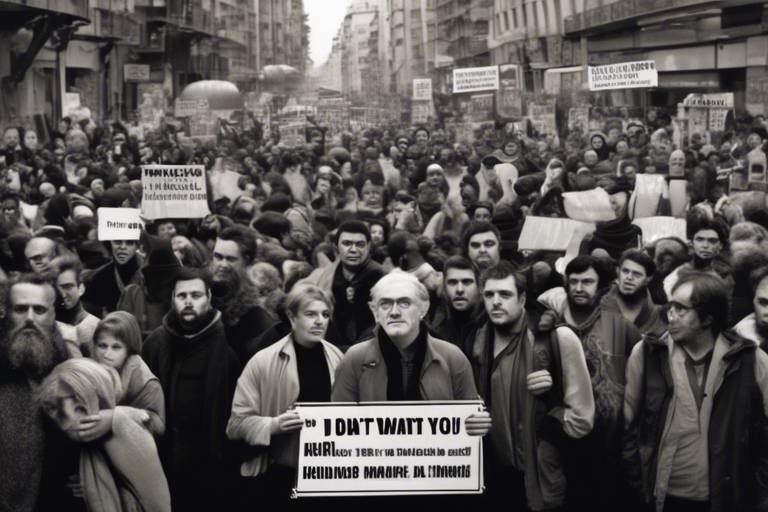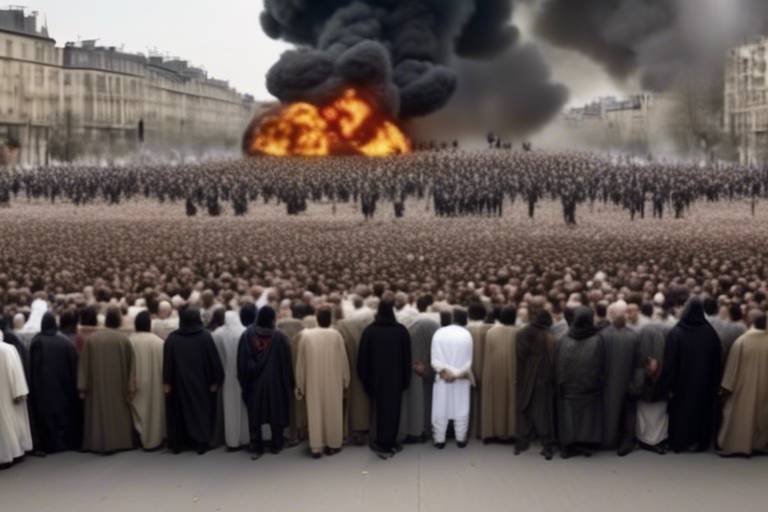The Philosophy of Gender: Implications for Politics
Gender is not just a simple binary; it is a complex tapestry woven from societal norms, cultural beliefs, and individual identities. In today's world, understanding gender as a social construct is crucial for grasping its implications in politics. This article aims to unravel the intricate relationship between gender and political structures, highlighting how our perceptions of gender influence policy-making and representation.
At its core, the philosophy of gender challenges us to rethink traditional notions of masculinity and femininity. It's about questioning why certain traits are attributed to one gender over another and how these attributions shape our interactions and societal expectations. For instance, why is emotional expression often seen as a weakness in men, while women are expected to be nurturing? These societal norms not only affect personal identities but also have profound implications for political engagement and representation.
As we navigate through the political landscape, it becomes evident that gender plays a pivotal role in shaping political ideologies. From feminist movements advocating for equal rights to the representation of non-binary individuals in government, the intersection of gender and politics is rich with both challenges and opportunities. The dynamics of power are often influenced by gendered perceptions, making it essential to analyze how these constructs affect policy decisions that impact our lives.
Moreover, the implications of gender extend beyond individual experiences; they permeate the very fabric of our political systems. For instance, consider how the lack of female representation in leadership roles can lead to policies that overlook women's needs. This disparity highlights the necessity of diverse voices in political discourse. As we delve deeper into this topic, it is crucial to acknowledge the contributions of feminist political theory, which has evolved over time to challenge traditional paradigms and advocate for a more inclusive political landscape.
In summary, the philosophy of gender is not merely an academic exercise; it is a vital lens through which we can examine the intricacies of political life. By understanding how gender shapes our perceptions and policies, we can work towards a more equitable society where every voice is heard and valued. The journey towards gender equality in politics is ongoing, and it requires active participation and critical reflection from all of us.
- What is gender as a social construct?
Gender as a social construct refers to the idea that gender roles and identities are created and maintained by societal norms rather than being strictly biological. This perspective allows for a more nuanced understanding of how individuals express their gender and how society responds to these expressions. - How does gender influence political representation?
Gender influences political representation by affecting who gets elected and whose voices are amplified in political discussions. The underrepresentation of women and non-binary individuals can lead to policies that do not address their needs, highlighting the importance of diverse representation in politics. - What role does language play in politics?
Language plays a significant role in politics as it shapes perceptions and can reinforce or challenge existing power dynamics. Gendered language can perpetuate stereotypes, while inclusive language practices can foster a more equitable political environment.

Understanding Gender as a Social Construct
When we talk about gender, it’s essential to understand that it is not merely a biological concept but rather a social construct. This means that our perceptions of gender are shaped significantly by societal norms, cultural practices, and historical contexts. Think about it: from the moment we are born, society starts to assign roles and expectations based on our assigned sex. This can lead to a narrow understanding of what it means to be male or female, often overlooking the rich spectrum of identities that exist beyond these binary classifications.
Traditionally, society has imposed rigid gender roles that dictate how individuals should behave, dress, and interact. For instance, boys are often encouraged to be tough and assertive, while girls are socialized to be nurturing and submissive. These expectations can be so deeply ingrained that they influence everything from childhood play to career choices. It’s like a script handed down through generations, where deviation from the norm can lead to social penalties. But what happens when someone steps off that script? This is where the beauty of gender as a construct comes into play.
Consider the following points that illustrate how gender is socially constructed:
- Media Representation: The media plays a crucial role in shaping our understanding of gender. From movies to advertisements, the portrayal of gender roles can reinforce stereotypes or challenge them.
- Cultural Norms: Different cultures have varying expectations for gender roles. What is considered masculine in one culture may not hold the same weight in another, highlighting the fluidity of gender.
- Historical Context: Gender roles have evolved over time. For example, the role of women in the workforce has changed dramatically over the last century, reflecting shifts in societal attitudes.
These factors contribute to the ongoing dialogue about gender identity and expression. As society progresses, more individuals are embracing their authentic selves, challenging the norms that have long dictated their lives. This shift is vital for fostering a more inclusive environment where everyone can thrive, regardless of their gender identity.
In essence, understanding gender as a social construct opens up a world of possibilities. It encourages us to question the status quo and recognize that our identities are not predetermined but rather shaped by our experiences and choices. This realization is not only empowering for individuals but also crucial for creating a more equitable society. By dismantling outdated notions of gender, we pave the way for a future where everyone can express their identity freely and authentically.
- What is the difference between sex and gender? Sex refers to the biological differences between males and females, while gender is a social construct that encompasses the roles, behaviors, and identities associated with being male, female, or non-binary.
- Can gender be fluid? Yes, many individuals experience their gender identity as fluid, meaning it can change over time or depending on the context.
- How does society influence our understanding of gender? Society influences our understanding of gender through cultural norms, media representation, and historical context, which shape our perceptions and expectations of gender roles.

The Intersection of Gender and Politics
The intersection of gender and politics is a complex tapestry woven from threads of identity, power, and societal norms. It's fascinating to observe how gender shapes not only individual experiences but also the very fabric of political systems. Have you ever thought about how the representation of gender in politics can influence policy decisions that affect our daily lives? The reality is that gender plays a pivotal role in determining who gets to make decisions and whose voices are heard. As we delve deeper into this intersection, we uncover the implications of gender on political ideologies, representation, and the experiences of marginalized groups.
At its core, the relationship between gender and politics is about power dynamics. Traditional political structures have often sidelined women's voices and perspectives, leading to a political landscape that does not reflect the diversity of the populace. This has prompted a call for increased representation of women and non-binary individuals in political spaces. For instance, studies have shown that when women hold political office, there tends to be a greater focus on issues such as healthcare, education, and social justice. This is not just a coincidence; it underscores the importance of having diverse voices in the room when decisions are made.
Moreover, the experiences of marginalized groups highlight the need for intersectionality in political discourse. Gender does not exist in a vacuum; it intersects with race, class, sexuality, and other identities, creating unique challenges for individuals. For example, women of color often face compounded discrimination, which can lead to their voices being further marginalized in political discussions. Recognizing these intersections is crucial for creating a more inclusive political environment. As we explore the impact of gender on political representation, it's essential to acknowledge that the fight for equality is not just about gender alone; it's about dismantling the systemic barriers that hinder true representation for all.
In recent years, there has been a notable shift towards recognizing the importance of gender in politics. This is evident in the rise of feminist movements that advocate for policy changes aimed at promoting gender equality. These movements have not only challenged traditional political paradigms but have also influenced the way we think about governance and leadership. The push for gender-sensitive policies has led to significant advancements, such as parental leave policies, reproductive rights, and initiatives aimed at combating domestic violence.
As we navigate this intricate landscape, it’s crucial to consider how political ideologies are shaped by gender perspectives. For example, feminist political theory has played a vital role in critiquing and reshaping policies that have historically overlooked women's needs. This is where the voices of key feminist thinkers come into play, as they challenge the status quo and advocate for a more equitable political framework. By examining the intersection of gender and politics, we can better understand the ongoing struggles and triumphs of those who seek to create a more just society.
- How does gender affect political representation? Gender affects political representation by influencing who is elected to office and whose issues are prioritized in policymaking.
- What is the role of feminist movements in politics? Feminist movements advocate for gender equality and push for policies that address women's rights and issues, significantly impacting political discourse.
- Why is intersectionality important in understanding gender and politics? Intersectionality is important because it acknowledges that individuals experience multiple identities that affect their political experiences differently, highlighting the need for inclusive representation.

Feminist Political Theory
Feminist political theory has emerged as a critical lens through which we can examine the intricate relationship between gender and power within political contexts. At its core, this theory challenges the traditional frameworks that have historically marginalized women's voices and experiences. It seeks to unravel the complexities of how gender influences political structures and ideologies, pushing for a more inclusive understanding of what politics entails. Just as a prism refracts light into a spectrum of colors, feminist political theory reveals the multiple layers of oppression and privilege that shape our political landscape.
One of the foundational aspects of feminist political theory is its emphasis on the **social construction of gender**. This idea posits that gender roles are not inherent or biologically determined but are instead created and reinforced through societal norms and expectations. By deconstructing these roles, feminist theorists argue for a re-examination of political ideologies that often overlook or misrepresent women's contributions and experiences. This perspective invites us to ask, "How can we reshape our political discourse to reflect the realities of all genders?"
Throughout history, several key thinkers have played a pivotal role in shaping feminist political thought. For instance, the works of **Simone de Beauvoir** and **Judith Butler** have significantly influenced how we understand gender identity and its implications for power dynamics. De Beauvoir’s assertion that "one is not born, but rather becomes a woman" challenges the notion of fixed gender identities, while Butler's concept of gender performativity suggests that gender is a series of acts rather than a stable identity. Together, these ideas have sparked discussions about the fluidity of gender and its relevance in political representation.
Moreover, feminist political theory has been instrumental in advocating for **policy changes** that address gender inequalities. Movements led by feminists have pushed for reforms in various areas, including reproductive rights, equal pay, and anti-discrimination laws. The success of these campaigns can be attributed to the tireless efforts of activists who have utilized feminist theory to highlight the systemic barriers faced by women and marginalized groups. For example, the **#MeToo movement** has galvanized global conversations about sexual harassment and violence, leading to significant shifts in workplace policies and societal attitudes.
As we continue to explore the implications of feminist political theory, it becomes clear that its relevance extends beyond gender alone. It intersects with issues of race, class, and sexuality, creating a rich tapestry of perspectives that challenge the status quo. This intersectionality not only broadens the scope of feminist analysis but also emphasizes the importance of inclusive dialogue in political discourse. By recognizing the diverse experiences of individuals within the feminist framework, we can foster a more equitable political environment that values all voices.
In conclusion, feminist political theory is not just an academic pursuit; it is a vital tool for understanding and transforming the political landscape. By questioning established norms and advocating for inclusive policies, feminist theorists and activists continue to pave the way for a more just society. As we reflect on the evolution of feminist thought, we must remain committed to engaging with these ideas and recognizing their profound impact on our political systems.
- What is the main goal of feminist political theory? The primary goal is to challenge and transform traditional political frameworks that have marginalized women's voices and experiences.
- Who are some key thinkers in feminist political theory? Influential figures include Simone de Beauvoir, Judith Butler, bell hooks, and Angela Davis, among others.
- How does feminist political theory intersect with other social justice movements? It intersects with issues of race, class, and sexuality, advocating for an inclusive approach to understanding power dynamics.
- What are some examples of successful feminist movements? Examples include the suffrage movement, the reproductive rights movement, and the #MeToo movement.

Key Feminist Thinkers
Throughout history, numerous feminist thinkers have emerged, each contributing unique perspectives that have shaped our understanding of gender and politics. These intellectuals have not only challenged the status quo but have also paved the way for new political paradigms that embrace equality and inclusivity. Let's take a closer look at some of the most influential figures in feminist political theory.
One of the earliest and most notable figures in feminist thought is Mary Wollstonecraft, whose seminal work, A Vindication of the Rights of Woman, published in 1792, argued passionately for women's education and rationality. Wollstonecraft's ideas laid the groundwork for future feminist movements, emphasizing that women should not be confined to domestic roles but should have the same opportunities for education and employment as men.
Fast forward to the 20th century, and we encounter the formidable Simone de Beauvoir. Her book, The Second Sex, published in 1949, is a cornerstone of feminist literature. De Beauvoir famously stated, "One is not born, but rather becomes, a woman," highlighting the distinction between biological sex and gender as a social construct. This idea has profoundly influenced feminist political theories, prompting discussions about the societal norms that dictate gender roles.
Another pivotal figure is bell hooks, an influential cultural critic and feminist theorist. In her works, such as Feminism is for Everybody, hooks emphasizes the importance of intersectionality—the idea that various forms of oppression, including race, class, and gender, intersect to create unique experiences of discrimination. This perspective has been crucial in expanding feminist discourse to include the voices of marginalized groups, advocating for a more inclusive approach to feminism.
Moreover, Judith Butler has significantly impacted contemporary feminist thought with her groundbreaking work, Gender Trouble. Butler argues that gender is performative, suggesting that our identities are constructed through repeated behaviors and societal expectations. This idea challenges rigid definitions of gender and encourages a more fluid understanding of identity, which has implications for political representation and activism.
To summarize, the contributions of these key feminist thinkers have been instrumental in shaping the landscape of feminist political theory. Their ideas continue to resonate today, inspiring new generations to challenge existing power structures and advocate for gender equality. Below is a brief overview of these thinkers and their contributions:
| Name | Key Work | Contribution |
|---|---|---|
| Mary Wollstonecraft | A Vindication of the Rights of Woman | Advocated for women's education and rationality. |
| Simone de Beauvoir | The Second Sex | Introduced the concept of gender as a social construct. |
| bell hooks | Feminism is for Everybody | Highlighted intersectionality in feminist discourse. |
| Judith Butler | Gender Trouble | Proposed the idea of gender performativity. |
These thinkers remind us that the struggle for gender equality is ongoing and that engaging with their ideas can empower us to challenge outdated norms and advocate for a more equitable society. Their legacies continue to inspire activism and policy changes that aim to dismantle systemic inequalities, making their work as relevant today as it was when first published.
- Who is considered the first feminist thinker? Many consider Mary Wollstonecraft to be one of the first feminist thinkers due to her early advocacy for women's rights and education.
- What is intersectionality in feminism? Intersectionality is a framework that examines how various forms of discrimination intersect, such as race, gender, and class, highlighting the unique experiences faced by individuals at these intersections.
- Why is Judith Butler's work important? Judith Butler's concept of gender performativity challenges traditional notions of gender, advocating for a more fluid understanding of identity that has significant implications for gender politics.

Feminism and Policy Change
Feminism has always been a powerful catalyst for change, especially in the realm of policy. From the suffragette movement in the early 20th century to today's ongoing battles for reproductive rights and equal pay, feminist movements have consistently challenged the status quo and pushed for reforms that promote gender equality. One of the most compelling aspects of feminism is its ability to mobilize communities, raise awareness, and advocate for policies that address the systemic inequalities faced by women and marginalized groups.
Take, for instance, the landmark legislation passed in various countries over the decades. Policies like the Equal Pay Act and the Violence Against Women Act in the United States have roots deeply embedded in feminist activism. These laws were not simply handed down; they emerged from a tireless effort by feminists who highlighted the urgent need for change. The advocacy work involved countless protests, lobbying efforts, and public awareness campaigns that brought attention to the injustices that women faced.
Moreover, feminism has played a crucial role in shaping international policies as well. Organizations such as the United Nations have recognized the importance of gender equality in achieving sustainable development goals. Feminist activists have influenced global discussions, pushing for policies that not only address women's rights but also consider the intersectionality of gender with race, class, and sexuality. This broader perspective is essential in crafting policies that are truly inclusive and effective.
In recent years, we have seen a rise in grassroots movements that leverage social media to advocate for policy change. The #MeToo movement is a prime example of how feminist activism can lead to significant shifts in societal attitudes and policies regarding sexual harassment and assault. By sharing personal stories and galvanizing public support, activists have pressured lawmakers to take action, leading to changes in legislation and workplace policies aimed at protecting individuals from harassment.
However, the journey toward comprehensive policy change is not without its challenges. Feminists often encounter resistance from entrenched political interests and societal norms that favor the status quo. Despite these obstacles, the resilience of feminist movements has shown that sustained advocacy can lead to meaningful reforms. For instance, the push for comprehensive reproductive rights has resulted in significant policy changes in various regions, although the fight continues in many others.
To illustrate the impact of feminism on policy change, consider the following table that outlines some key feminist movements and their corresponding policy achievements:
| Feminist Movement | Key Achievements |
|---|---|
| Suffragette Movement | Women's right to vote in various countries. |
| Second-Wave Feminism | Legalization of abortion and anti-discrimination laws. |
| Third-Wave Feminism | Focus on intersectionality and LGBTQ+ rights. |
| #MeToo Movement | Increased awareness and legislative changes regarding sexual harassment. |
In conclusion, the relationship between feminism and policy change is dynamic and ongoing. As society evolves, so too do the challenges and opportunities for feminist advocacy. The work of feminists is crucial in ensuring that policy frameworks are not only responsive to the needs of women but also promote a broader agenda of social justice and equality. The future of gender equality relies on the continued engagement of feminist movements in political discourse and policy-making processes, ensuring that every voice is heard and every issue addressed.
- What is the primary goal of feminism in relation to policy change? Feminism aims to address and rectify systemic inequalities faced by women and marginalized groups through advocacy for equitable policies.
- How can individuals support feminist movements? Individuals can support feminist movements by educating themselves, participating in advocacy efforts, and amplifying marginalized voices in discussions about policy.
- What are some current issues that feminist movements are addressing? Current issues include reproductive rights, equal pay, gender-based violence, and the representation of diverse gender identities in politics.

Gender Identity and Political Representation
The landscape of political representation is evolving, and one of the most significant changes is the recognition of gender identity as a crucial factor in ensuring diverse representation. This shift is not merely about the number of individuals from various gender identities in political spaces; it's about the experiences, perspectives, and voices they bring with them. When we talk about gender identity, we're not just referring to male and female; we’re acknowledging a spectrum that includes non-binary, genderqueer, and transgender identities. Each of these identities contributes to a richer, more nuanced political discourse.
However, the journey toward equitable political representation is fraught with challenges. Many individuals face systemic barriers that hinder their participation in politics. For instance, those who identify as transgender or non-binary often encounter discrimination, lack of understanding, and outright hostility when attempting to engage in political processes. This can manifest in various ways, from exclusionary language in political discourse to policies that do not recognize or support their identities. As a result, the voices of these individuals are often marginalized, leading to a political landscape that fails to reflect the true diversity of society.
To illustrate the importance of representation, consider the following table that outlines the current state of gender representation in various political bodies:
| Political Body | Percentage of Female Representatives | Percentage of LGBTQ+ Representatives |
|---|---|---|
| U.S. Congress | 27% | 7% |
| European Parliament | 40% | 5% |
| Local Governments (U.S.) | 30% | 3% |
This table highlights a stark reality: while there have been strides in increasing female representation, the presence of LGBTQ+ individuals remains significantly low. The underrepresentation of diverse gender identities in political arenas means that policies often overlook the unique needs and challenges faced by these groups. For example, issues such as healthcare access, employment rights, and protections against discrimination are frequently sidelined when the decision-makers lack firsthand experience or understanding of these matters.
Moreover, the representation of diverse gender identities is crucial for fostering inclusive policies that benefit society as a whole. When individuals from various backgrounds participate in the political process, they bring different experiences and insights that can lead to more comprehensive and effective legislation. This is not just about fairness; it's about creating a political environment where all voices are heard and valued.
As we look to the future, it’s essential to advocate for policies that support the participation of individuals from all gender identities in politics. This includes implementing affirmative action measures, promoting inclusive language in political discourse, and providing resources for education and training on gender identity issues. By doing so, we can work towards a political landscape that truly reflects the diversity of our society and addresses the needs of all its members.
- Why is gender representation important in politics?
Gender representation ensures that diverse perspectives are included in the decision-making process, leading to policies that are more equitable and reflective of society's needs.
- What challenges do individuals with non-binary identities face in politics?
Non-binary individuals often face discrimination, lack of understanding, and exclusionary practices that hinder their political participation.
- How can we improve gender representation in political spaces?
Improving gender representation can be achieved through affirmative action, education on gender issues, and promoting inclusive practices in political discourse.

Gendered Language in Politics
Language is not just a tool for communication; it is a powerful force that shapes our realities and influences our perceptions. In the realm of politics, gendered language plays a crucial role in framing discussions, shaping policies, and influencing public opinion. When we talk about gendered language, we are referring to the ways in which language reflects and perpetuates gender norms and biases. For instance, terms like "mankind" and "manpower" can inadvertently reinforce the notion that men are the default or primary actors in society, sidelining the contributions and existence of women and non-binary individuals.
Moreover, the implications of gendered language extend beyond mere semantics. It can significantly impact political discourse and engagement. When language is steeped in traditional gender norms, it can alienate those who do not conform to these norms, making it difficult for diverse voices to be heard in political arenas. This is particularly evident in political speeches and debates, where the use of masculine pronouns and terms can create an environment that feels unwelcoming to women and gender minorities. Can you imagine how many potential leaders might feel discouraged from participating in politics if the language used consistently excludes them?
To illustrate the impact of gendered language in politics, consider the following table that highlights common gendered terms and their more inclusive alternatives:
| Gendered Term | Inclusive Alternative |
|---|---|
| Chairman | Chairperson |
| Police man | Police officer |
| Fireman | Firefighter |
| Congressman | Member of Congress |
By adopting inclusive language practices, we can foster a political environment that is more equitable and representative of diverse identities. This means not only avoiding gendered terms but also actively seeking out ways to include all genders in political discussions. For example, using "they" as a singular pronoun can be a simple yet effective way to acknowledge non-binary individuals and create a more inclusive dialogue. The challenge lies in changing long-standing habits and encouraging political leaders, institutions, and the media to embrace more inclusive language.
Ultimately, the language we use in politics reflects our values and beliefs about gender. As society evolves, so too should our language. Emphasizing inclusive language practices in political communication is not just a matter of sensitivity; it is essential for creating a political landscape where everyone feels valued and represented. The question remains: how can we collectively advocate for these changes in our political discourse?
- What is gendered language? Gendered language refers to words and phrases that reflect or reinforce gender distinctions and biases.
- Why is inclusive language important in politics? Inclusive language helps create a welcoming environment for all individuals, ensuring that diverse voices are heard and represented in political discussions.
- How can I promote inclusive language in my community? You can promote inclusive language by using gender-neutral terms, encouraging others to do the same, and advocating for changes in official documents and communications.

Language and Power Dynamics
Language is not merely a tool for communication; it is a potent instrument that shapes our realities and influences power dynamics within society. When we examine the interplay between language and power, we uncover how the words we choose can either reinforce or challenge existing hierarchies. For instance, political discourse often employs specific language that can perpetuate stereotypes or marginalize certain groups. Have you ever noticed how certain terms can evoke strong emotional responses, while others seem to neutralize the conversation? This is no coincidence; the language we use carries weight and can sway public opinion significantly.
Consider the implications of using gendered language in political settings. Terms like "mankind" versus "humankind" can subtly shape perceptions about gender roles. When leaders use inclusive language, they send a powerful message that all voices matter, fostering a sense of belonging among diverse populations. Conversely, the persistent use of gendered terms can alienate individuals who do not fit within traditional binaries, thereby reinforcing a culture of exclusion. This dynamic raises a crucial question: How can we transform our language to reflect a more equitable society?
To illustrate the impact of language on power dynamics, let's look at a simple comparison:
| Language Type | Impact on Power Dynamics |
|---|---|
| Gendered Language | Reinforces traditional gender roles and hierarchies |
| Inclusive Language | Promotes equality and acknowledges diverse identities |
As we delve deeper into this subject, it becomes clear that language not only reflects societal norms but also has the power to challenge them. Politicians and leaders who adopt inclusive language practices can reshape political narratives and create a more equitable environment. By consciously choosing words that uplift and empower, they can dismantle the barriers that have historically marginalized certain groups.
Moreover, the language of power is often steeped in metaphor and symbolism. Political speeches are replete with metaphors that frame issues in ways that resonate with audiences. For instance, referring to a political struggle as a "battle" can evoke images of conflict and urgency, compelling listeners to take action. This rhetorical strategy highlights how language can mobilize support and influence public sentiment. However, it also raises ethical questions about the narratives we construct and the potential consequences of those narratives.
In conclusion, the relationship between language and power dynamics is intricate and profound. As we engage in political discourse, we must remain vigilant about the language we use. Are we perpetuating inequalities, or are we fostering inclusivity? The answers to these questions will shape the future of our political landscape. By embracing language as a tool for empowerment, we can pave the way for a more just society where every voice is heard and valued.
- How does language influence political power? Language shapes perceptions and can reinforce or challenge existing power structures.
- What is inclusive language? Inclusive language acknowledges and respects diverse identities, promoting equality in communication.
- Why is gendered language problematic? It can perpetuate stereotypes and marginalize individuals who do not fit traditional gender roles.
- How can we promote inclusive language in politics? By consciously choosing words that uplift and empower all individuals, regardless of their gender identity.

Inclusive Language Practices
When we talk about inclusive language, we are diving into a powerful tool that can reshape our political conversations. Language is not just a means of communication; it’s a reflection of our values and beliefs. In political discourse, the words we choose can either empower or exclude. By adopting inclusive language practices, we can create a more welcoming and equitable environment for all individuals, regardless of their gender identity.
One of the first steps in implementing inclusive language is to recognize the importance of pronouns. Using the correct pronouns for individuals is a basic form of respect and acknowledgment of their identity. For instance, referring to someone as “they/them” if that’s their preference is not just a matter of politeness; it’s an affirmation of their existence and identity. This practice challenges the traditional binary view of gender, opening up a world where everyone feels seen and validated.
Moreover, inclusive language can be applied to various aspects of political communication, from speeches to written documents. For example, instead of using terms like “mankind,” which inherently excludes half of the population, we can opt for “humankind” or “people.” Such changes might seem minor, but they send a clear message: everyone belongs in the conversation. By consciously choosing words that reflect diversity, we can break down barriers that have historically marginalized certain groups.
To further illustrate the impact of inclusive language, consider the following table that highlights common terms and their inclusive alternatives:
| Traditional Term | Inclusive Alternative |
|---|---|
| Chairman | Chair or Chairperson |
| Policeman | Police Officer |
| Fireman | Firefighter |
| Manpower | Workforce |
Incorporating these alternatives into everyday language not only promotes inclusivity but also encourages others to reflect on their own language choices. It’s about creating a ripple effect where the use of inclusive language becomes the norm rather than the exception. However, it’s essential to approach this transition with sensitivity and understanding. Not everyone may be familiar with these practices, and some may need time to adjust. Education and open dialogue are crucial in this process.
Another effective strategy is to encourage the use of gender-neutral terms in political documents. For instance, instead of addressing an audience as “ladies and gentlemen,” one might say “everyone” or “distinguished guests.” This simple shift can make a significant difference in how individuals perceive their participation in political discussions. When people feel included, they are more likely to engage, contribute, and advocate for their rights and interests.
In conclusion, adopting inclusive language practices in politics is not merely a trend; it’s a necessary evolution towards a more equitable society. By being conscious of our language and making intentional choices, we can foster an environment where all voices are heard and valued. The journey towards inclusivity is ongoing, and every small change counts. So, let’s start today—because language matters, and it has the power to change the world.
- What is inclusive language?
Inclusive language refers to communication that avoids bias and promotes equality, making sure that all individuals feel represented and respected. - Why is inclusive language important in politics?
It helps create a more equitable political environment, ensuring that diverse voices are heard and valued, thus fostering greater engagement and participation. - How can I practice inclusive language?
Start by using correct pronouns, opting for gender-neutral terms, and being mindful of the language you use in political discussions and writings.

Future Directions in Gender and Politics
As we look ahead, the landscape of gender and politics is poised for significant transformation. The discussions surrounding gender are evolving rapidly, reflecting broader societal changes. With the rise of social media and grassroots movements, individuals are more empowered than ever to voice their opinions and advocate for their rights. This shift is not just a passing trend; it indicates a profound change in how we perceive and engage with gender issues in political contexts. The question remains, how can we harness this momentum to create a more equitable political environment?
One of the most exciting prospects is the increasing visibility of non-binary and genderqueer identities in political discourse. As society begins to embrace a spectrum of gender identities, political frameworks must adapt accordingly. This means not only recognizing diverse identities but also ensuring that political representation reflects this diversity. Imagine a political landscape where individuals from all gender backgrounds can see themselves represented in leadership roles. This could lead to more inclusive policies that address the unique challenges faced by marginalized communities.
Moreover, the integration of intersectionality into political discussions is crucial. Intersectionality acknowledges that individuals experience overlapping identities, such as race, class, and gender, which can compound discrimination and inequality. Future political movements must prioritize intersectional approaches to policy-making, ensuring that the voices of those who are often overlooked are amplified. This could involve actively seeking input from diverse groups during policy formulation, leading to more comprehensive and effective solutions.
Another vital direction is the push for gender-sensitive policies. These policies are designed to consider the different impacts that legislation can have on various genders. For instance, policies in healthcare, education, and employment should be evaluated through a gender lens to identify potential disparities. By doing so, we can create systems that promote equality and address the unique needs of all genders. The challenge lies in convincing policymakers of the importance of this approach, but as public awareness grows, so too does the potential for change.
Additionally, the role of education cannot be overstated. Educational institutions have the power to shape future generations' understanding of gender and politics. By incorporating gender studies into curricula, we can foster a culture of awareness and respect from a young age. This education can empower students to challenge stereotypes and advocate for equality in their communities. As these students grow into future leaders, they will carry these values into political spaces, paving the way for a more inclusive future.
In conclusion, the future of gender and politics is bright, but it requires collective effort and commitment. By embracing diversity, advocating for intersectionality, implementing gender-sensitive policies, and prioritizing education, we can create a political landscape that truly reflects the needs and aspirations of all individuals. The journey may be complex, but the potential for meaningful change is within our reach. Are we ready to take the necessary steps to ensure that future generations inherit a world where gender equality is not just an ideal, but a reality?
- What is gender-sensitive policy? Gender-sensitive policy considers the different impacts that legislation can have on various genders, aiming to promote equality.
- How can education influence gender politics? Education can shape understanding and attitudes towards gender, empowering future leaders to advocate for equality.
- What does intersectionality mean in political contexts? Intersectionality acknowledges that individuals experience overlapping identities that can compound discrimination and inequality.
- Why is representation important in politics? Representation ensures that diverse voices and experiences are included in decision-making processes, leading to more equitable policies.
Frequently Asked Questions
- What is the philosophy of gender?
The philosophy of gender examines the nature of gender as a social construct, exploring how societal norms and expectations shape our understanding of gender roles and identities. It looks at the implications of these constructs on various aspects of life, including politics, culture, and individual identity.
- How does gender intersect with politics?
Gender intersects with politics by influencing political representation, policy-making, and the experiences of marginalized groups. This intersectionality highlights how different identities experience political engagement and representation, often revealing disparities and challenges faced by various groups.
- What is feminist political theory?
Feminist political theory is a branch of political thought that critiques traditional political paradigms through a gendered lens. It examines how historical and contemporary political structures perpetuate gender inequalities and advocates for the inclusion of feminist perspectives in political discourse and policy-making.
- Who are some key feminist thinkers?
Key feminist thinkers include Simone de Beauvoir, Judith Butler, and bell hooks, among others. Each has contributed significantly to feminist thought, challenging existing norms and advocating for gender equality through their writings and activism.
- What role do feminist movements play in policy change?
Feminist movements have been instrumental in advocating for policy changes that promote gender equality. Through grassroots campaigns, lobbying, and awareness-raising initiatives, these movements have successfully influenced legislation on issues such as reproductive rights, equal pay, and violence against women.
- Why is gender identity important in political representation?
Gender identity is crucial in political representation because it ensures that diverse perspectives and experiences are included in decision-making processes. When individuals from various gender identities are represented, it leads to more equitable policies and a political environment that reflects the needs of all citizens.
- How does language influence political discourse?
Language plays a significant role in shaping political discourse by influencing perceptions of gender and power dynamics. Gendered language can reinforce stereotypes and biases, while inclusive language promotes equality and encourages broader participation in political discussions.
- What are inclusive language practices in politics?
Inclusive language practices involve using gender-neutral terminology and avoiding language that perpetuates stereotypes. By adopting such practices, political communication can become more equitable, fostering an environment where all individuals feel represented and valued.
- What are the future directions in the study of gender and politics?
Future directions in the study of gender and politics include exploring emerging trends such as intersectionality, the impact of technology on gender representation, and the ongoing fight for gender equality in political contexts. Continued dialogue and action are essential to address existing disparities and promote inclusivity.



















